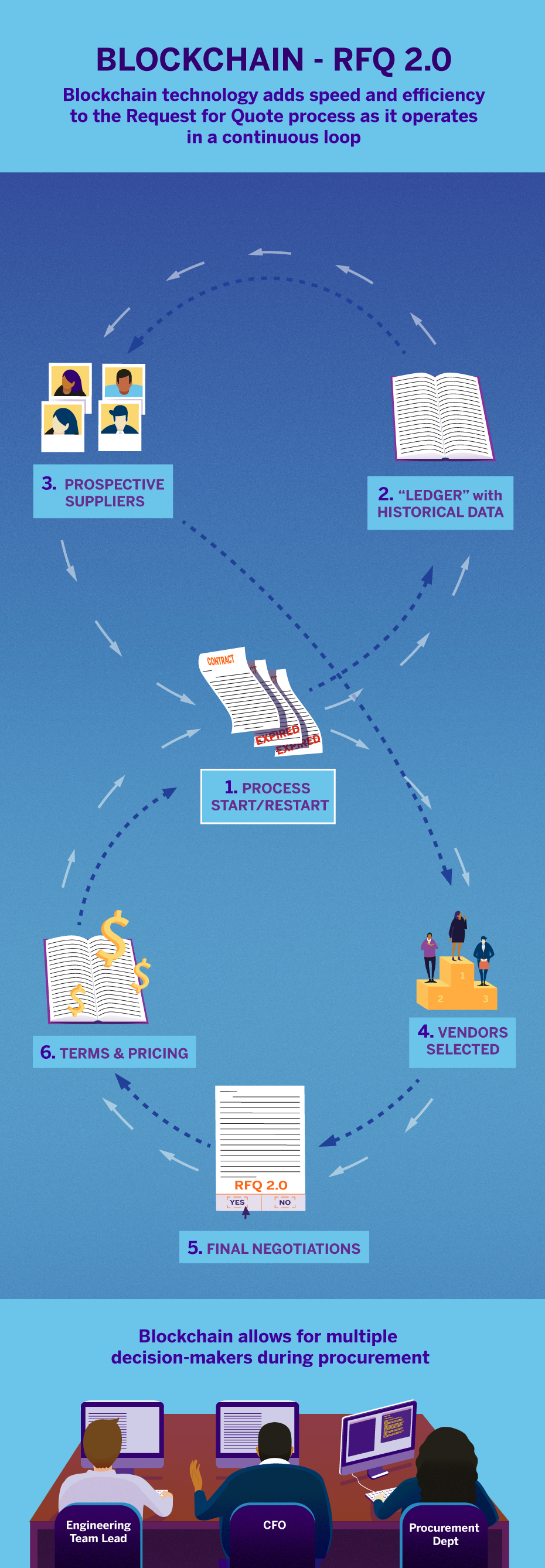- Home
- / Insights
- / FTI Journal
- / Blockchain Procurement Middleman
Blockchain, Procurement and the Middleman

-
April 16, 2018
-
For startups, disruptors and legacy companies alike, a centralized data authority adds a layer of time, labor and cost to the procurement process. Replacing that “middleman” with blockchain technology improves efficiency all around.
Eliminate the middleman. That tactic has been key to disrupting industries in the digital age. As new players like Uber, Airbnb and other peer-to-peer enterprises have come online, they have eaten the lunch of legacy companies by removing layers that once stood between consumer and vendor. The result has been improvements in speed and efficiency, as well as cost savings for end users.
Turns out the disruptors are ripe for some disruption themselves. While Uber and the like have broken down traditional business silos, these newbies still rely on a middleman of sorts — a centralized data collection and processing system — that imposes control and fees. This layer could be pared back by implementing blockchain technology, a digital ledger system that increases efficiency and lowers costs by reducing the reliance on centralized coordination.
Blockchain, which originated to support bitcoin transactions, shifts responsibility for creating and managing an audit trail from manual to automatic. Because it is an open database distributed among multiple users, blockchains are capable of handling massive amounts of data. It also features built-in cybersecurity, due diligence and transparency that prevent fraud.
Any enterprise that relies on a centralized authority for data management can gain from blockchain technology.
The benefits of using blockchain go beyond the disruptors, however; any enterprise that relies on a centralized authority for data management can gain from blockchain technology. This includes the likes of Amazon, eBay, supply chain companies, and even banks.
To illustrate that point, let’s look at one area of business ripe for disruption: procurement.
The New Gatekeepers
The procurement process is rigid and laborious. From the moment your procurement department or organization decides to renegotiate a contract or host a Request for Quote (RFQ), time starts dragging towards contract stage. It can take as long as 16 weeks to work through data collection, vendor bidding and selection, negotiations and contract signing. Along the way, procurement acts as a middleman by monitoring the process, reviewing and prodding the schedule as needed.
Blockchain solutions can streamline and liberate that process. For example, imagine that your procurement department observes in its copy of the blockchain database that the business is running low on bolts, or that the contract with the bolt vendor is about to expire. The path to restocking begins when a blockchain-based “smart contract“ automatically generates a new RFQ (“RFQ 2.0”) from vendors. From there, automation shaves weeks or even months off the time and effort it takes to reach the vendor bidding stage and ultimately complete the RFQ 2.0 process by digitally “signing” a new contract for more bolts.
Since all coordinating parties share the blockchain, the technology provides visibility beyond procurement, which in turn enhances transparency. In fact, designated executives (such as a CFO) and stakeholders (an engineering team lead) become gatekeepers along with the procurement department to form a consensus on the winner of the RFQ 2.0.
The path from RFQ 2.0 to contract signing flows in a continuous sequence using blockchain applications. When the new contract nears expiration, or restocking is needed, the process starts again. Below are points showing how the procurement process works followed by an infographic that illustrates the points.
Process Start/restart
An expired contract initiates the RFQ 2.0 process. Alternatively, a violation of a Service Level Agreement (SLA) can also trigger the process as shown in point 2 below. This enables procurement to stay current in the market and maintain continuously competitive pricing.
“Ledger” with Historical Data
The RFQ 2.0 process begins by maintaining your transactional order/purchasing history within the blockchain. This will determine:
- All products/skus purchased from a certain type of vendor
- Quantity of each sku
- Total spend and average cost of each sku
Utilizing this information, your baseline spend analysis is created automatically.
Prospective Suppliers Receive Info
A tokenized (encrypted and access controlled) version of the information in point 2 is sent to a preselected group of suppliers. The information included:
- All products/skus required for your upcoming year (based on what you purchased the previous year)
- Historical quantity ordered
- NOT prices or total spend
Vendors Selected
Vendors return their initial response in a timeframe designated by the customer (typically 1 to 2 weeks). Finalists are chosen through automation (if you want) using criteria such as:
- Top 5 vendors
- Top 10% of vendors
- Incumbent vendor is automatically a finalist
Final Negotiations
Results of the RFQ 2.0 go to procurement for review and final negotiations. Designated executives (CFO) and stakeholders (engineering team lead) join procurement as gatekeepers instead of middlemen to decide on the winning bid.
Terms and Pricing Entered
Contract terms and new pricing create an updated smart contract on the blockchain. Because a smart contract is programmable, you can install multiple SLAs that might trigger the RFQ 2.0 to begin again. Some examples of SLA violations that might trigger this action include:
- Pricing discrepancy
- Goods receiving later than expected
- Product quality is worse than expected
© Copyright 2018. The views expressed herein are those of the author(s) and not necessarily the views of FTI Consulting, Inc., its management, its subsidiaries, its affiliates, or its other professionals.
About The Journal
The FTI Journal publication offers deep and engaging insights to contextualize the issues that matter, and explores topics that will impact the risks your business faces and its reputation.
Published
April 16, 2018



